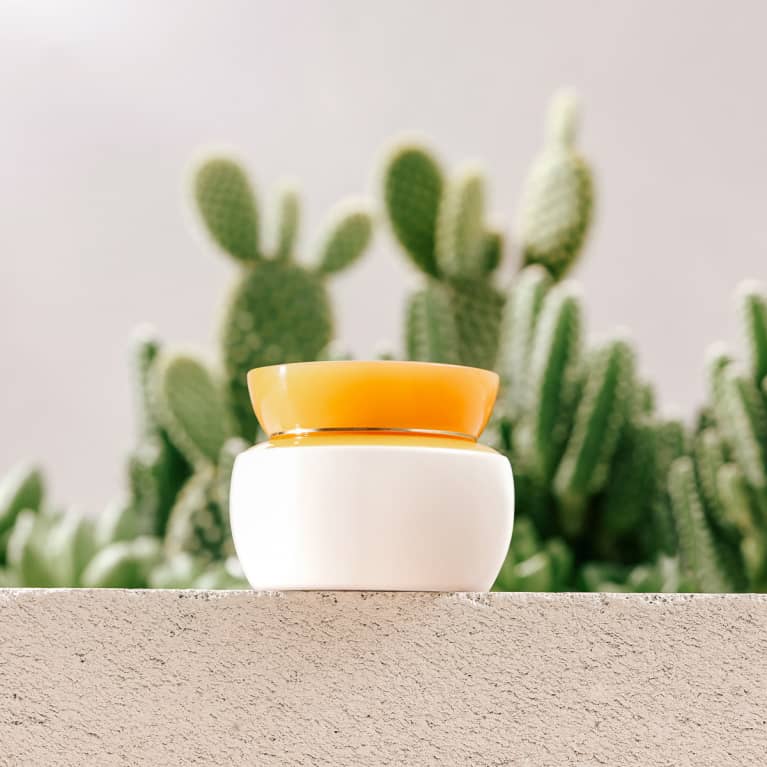
This Soothing Topical Just Might Change Your Dry, Inflamed Skin
by Contributing writerIn This Article
When you think of moisturizing ingredients—panthenol probably doesn't come to mind. It's often overlooked by well-known superstars, like aloe or hyaluronic acid. Yet, it's commonly used in personal products; you can find it in face creams, serums, shampoo—even mascara. Here, we dive into the science behind panthenol and how it soothes the skin.
What is panthenol?
Panthenol is a compound that's structurally similar to vitamin B5, or pantothenic acid. It's also known as provitamin B5 because it converts into vitamin B5 in the skin. Chemically, pantothenol is an alcohol, which means it has a hydroxyl group (an oxygen and a hydrogen bonded together). This hydroxyl group is what makes panthenol different from pantothenic acid.
Speaking of pantothenic acid—it's an essential nutrient that's found in every living cell. It's required to make coenzyme A, a compound that's necessary for essential enzymatic processes (and therefore, life). The body only needs small amounts of pantothenic acid.
Panthenol, on the other hand, is frequently added to personal products due to its effects on the skin. It's usually used in the form of a transparent viscous liquid, but it can also be used as a white powder. You can find panthenol listed on labels as pantothenol, D-pantothenol alcohol, dexpanthenol, or provitamin B5.
What does it do for the skin?
Here's why skin care brands use panthenol in their formulas:
1. It acts as a moisturizer.
Panthenol primarily functions as a moisturizer. According to board-certified dermatologist Jessie Cheung, M.D., panthenol is "a liquid at room temperature, so it's used as a humectant and emollient in skin care products." (Humectants attract moisture, while emollients fill in cracks with lipids.) This reduces water loss, keeping the skin soft and smooth.
The ingredient also restores and protects the skin barrier, which is essential for managing general dryness and skin sensitivity. Scientists are still learning how it exactly works, but they think its role in enzymatic processes—which is vital for skin barrier function—plays a part. Moreover, animal studies have found that it increases the mobility of lipids and proteins in the stratum corneum (outermost skin layer), resulting in improved hydration.
2. It reduces inflammation.
As panthenol converts into pantothenic acid (which then makes coenzyme A), it also helps decrease inflammation. That's because coenzyme A "is necessary for the production of steroids and fatty acids, which soothe inflammation," says Cheung. This anti-inflammatory effect makes it useful for alleviating symptoms of skin irritation, including itching, scaling, dryness, and roughness. In fact, many sunscreens and after-sun products contain panthenol for this reason.
3. It supports wound healing.
By mediating inflammation, panthenol can also help the wound healing process. It's been shown to decrease erythema, or skin reddening, when applied to wounds in the top layer of the skin. Its ability to attract moisture (and control water loss) also encourages skin regeneration, further supporting wound recovery.
Cheung adds that panthenol speeds up cell turnover and stimulates fibroblasts in the skin. This is crucial for wound healing, as fibroblasts are necessary for creating structural skin proteins like collagen and elastin. These proteins are key for facilitating proper tissue repair and wound closure—and ultimately, happy skin.
Are there side effects?
When used topically, panthenol is generally well-tolerated. Reactions are rare, explains Cheung, which means most people can use the ingredient without developing unpleasant symptoms. However, like all chemicals, panthenol can still lead to side effects in some people. When it does, "it can cause irritation or allergic contact dermatitis," says Cheung.
It's also worth noting that panthenol is sometimes used in food or as a supplement. In this regard, "panthenol is considered 'generally recognized as safe' by the Food and Drug Administration," shares Cheung.
The bottom line.
You'll likely find panthenol in most of your skin care and cosmetic products. The compound, which turns into vitamin B5 in the body, has stellar moisturizing and anti-inflammatory properties. It also works well with many ingredients—and you can't really overuse it, according to Cheung. For best results, always follow the directions when using a formula with panthenol, just as you would with any product.